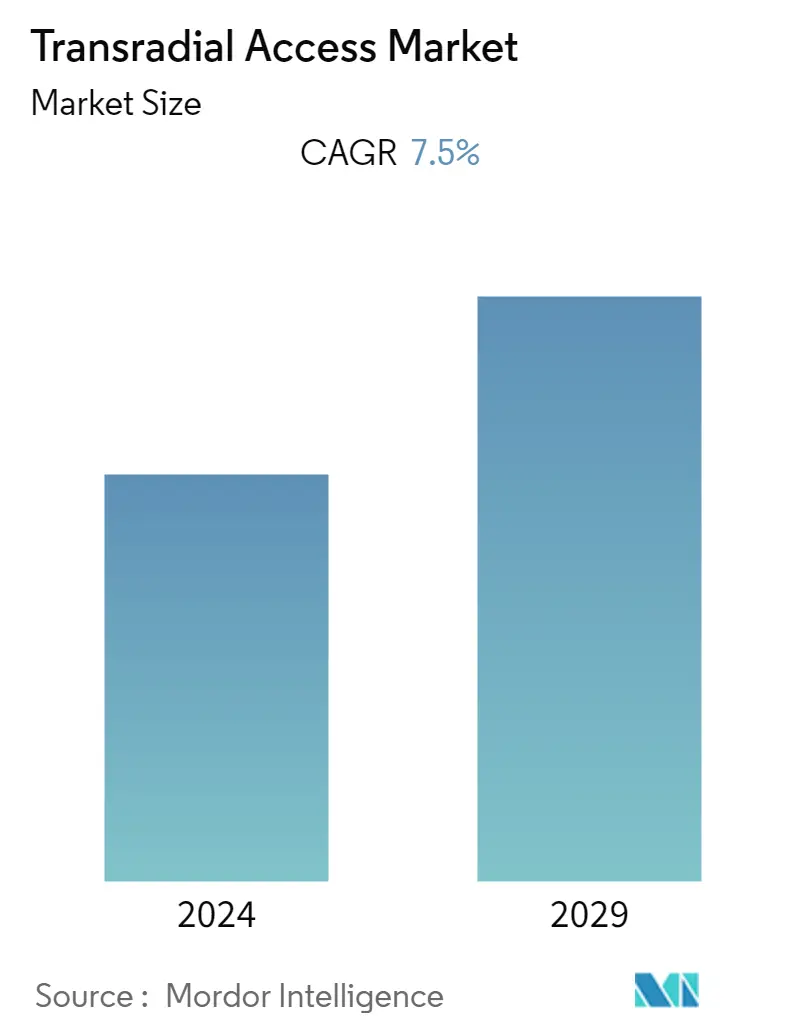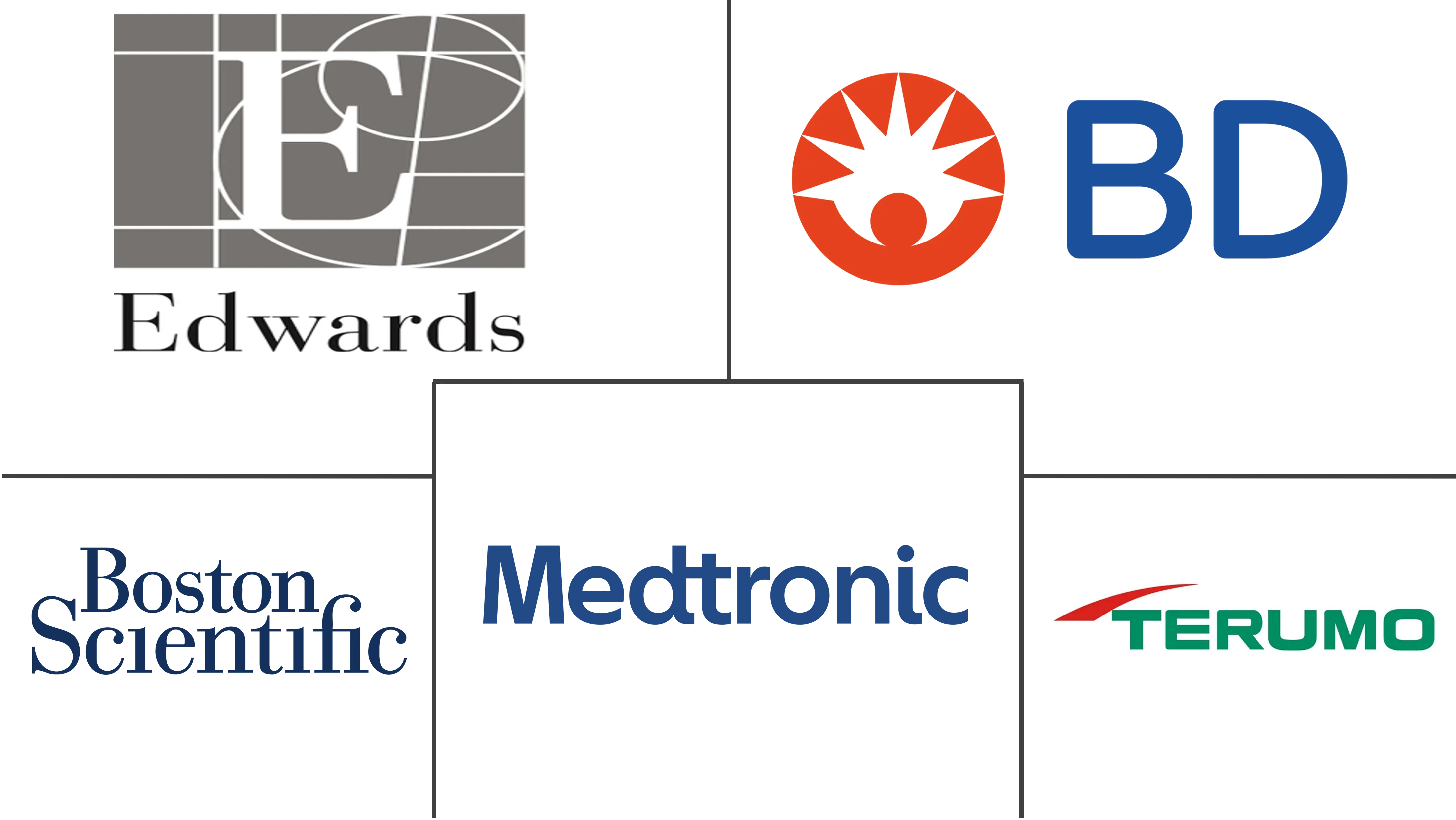Market Size of Transradial Access Industry

| Study Period | 2021 - 2029 |
| Base Year For Estimation | 2023 |
| CAGR | 7.50 % |
| Fastest Growing Market | Asia Pacific |
| Largest Market | North America |
| Market Concentration | High |
Major Players
*Disclaimer: Major Players sorted in no particular order |
Transradial Access Market Analysis
The transradial access devices market is expected to register a CAGR of 7.5% over the forecast period.
The COVID-19 pandemic substantially affected the treatment and diagnostic procedures for cardiac practices owing to delayed diagnosis and multiple postponed appointments, thereby impacting the growth of the studied market for transradial access devices. Furthermore, many studies suggested that people with cardiac diseases were particularly vulnerable to COVID-19, which led to a decrease in footfalls in hospitals and diagnostic centers. For instance, according to the research study published by the NCBI in May 2021, during the COVID-19 pandemic, cardiac procedural activity in England decreased dramatically, with a deficit of about 45,000 procedures. Moreover, a study published in Frontiers in Family Medicine and Primary Care in December 2021 stated that in Germany, despite having symptoms of coronary artery disease (CAD), 9.1% of patients did not see a medical practitioner due to a fear of becoming infected with COVID-19. However, the study's findings also detailed that most patients received adequate medical care during the COVID-19 pandemic for CAD. As a result of the growing availability of cardiac diagnosis and treatments, the market is expected to be favorably influenced in the latter phase, as per the analysis.
The transradial access devices market is growing due to the increasing preference for interventional procedures using radial artery access, the growing prevalence of cardiovascular diseases due to lifestyle disorders, and the increasing use of radial access devices in pediatric patients.
According to the WHO data updated in June 2021, nearly 33.5 million people globally are suffering from atrial fibrillation (AFib), which is the most common type of serious arrhythmia. Moreover, the British Heart Foundation's report published in July 2021 reported that 7.6 million people in the United Kingdom live with heart and circulatory diseases. Further, according to the 2022 AHA report, approximately 244.1 million people were living with IHD around the world. North Africa, the Middle East, Central, and South Asia, and Eastern Europe had the highest prevalence rates of IHD in the world in 2020. With the rise in the aging population worldwide, the number of patients suffering from heart rhythm disorders is likely to increase. This will lead to increased adoption of transradial access, which is expected to drive the growth of the studied market.
A scientific study published by the AHA in August 2021 stated that lower extremity peripheral artery disease (PAD) affects more than 230 million people worldwide and is linked to an elevated risk of several unfavorable clinical outcomes (including cardiovascular diseases like coronary heart disease and stroke and limb outcomes like amputee status). The increased incidence of PAD ultimately boosts the demand for interventional procedures requiring transradial access, augmenting the market's growth over the forecast period.
However, the major restraining factor for the market's growth is the high costs involved in the placement and maintenance of vascular access devices and the lack of trained professionals, which poses significant challenges.
Transradial Access Industry Segmentation
As per the scope of the report, transradial access is required for a catheterization procedure performed for the diagnosis and treatment of arterial diseases such as peripheral artery disease and coronary artery disease, among others. The transradial access market is segmented by Product (Catheters, Guidewires, Sheaths, Sheath Introducers, and Accessories), Application (Drug Administration, Fluid And Nutrition Administration, Blood Transfusion, Diagnostics & Testing), End User (Hospitals, Clinics, and Ambulatory Care Centers, and Others), and Geography (North America, Europe, Asia-Pacific, Middle East and Africa, and South America). The market report also covers the estimated market sizes and trends for 17 different countries across major regions, globally. The report offers the value (in USD million) for the above segments.
| By Product | |
| Catheters | |
| Guidewires | |
| Sheaths and Sheath Introducers | |
| Accessories |
| By Application | |
| Drug Administration | |
| Fluid and Nutrition Administration | |
| Blood Transfusion | |
| Diagnostics and Testing |
| By End User | |
| Hospitals | |
| Clinics and Ambulatory Care Centers | |
| Others |
| Geography | ||||||||
| ||||||||
| ||||||||
| ||||||||
| ||||||||
|
Transradial Access Market Size Summary
The transradial access devices market is poised for significant growth, driven by the increasing preference for interventional procedures utilizing radial artery access and the rising prevalence of cardiovascular diseases linked to lifestyle disorders. The market's expansion is further supported by the growing use of these devices in pediatric patients. Despite the challenges posed by the COVID-19 pandemic, which led to a temporary decline in cardiac procedures due to delayed diagnoses and reduced hospital visits, the market is expected to recover and thrive as cardiac diagnosis and treatment options become more accessible. The aging global population and the increasing incidence of heart rhythm disorders are anticipated to further propel the adoption of transradial access, thereby enhancing market growth.
North America is projected to experience the highest growth rate in the transradial access devices market, fueled by the increasing prevalence of cardiovascular diseases, a surge in conferences and workshops, and a rise in research and clinical trials focused on vascular access devices. The region's well-established healthcare industry and escalating healthcare expenditure are expected to drive the development of new products, including transradial access devices. The competitive landscape of the market is characterized by both major and local players, with key companies such as Becton, Dickinson and Company, Boston Scientific Corporation, Edward Lifesciences Corporation, Medtronic plc, and Terumo Corporation playing pivotal roles. Recent advancements, such as Medtronic's CE mark approval for its radial artery access portfolio, highlight the ongoing innovation and investment in this sector, underscoring the market's potential for robust growth over the forecast period.
Transradial Access Market Size - Table of Contents
-
1. MARKET DYNAMICS
-
1.1 Market Overview
-
1.2 Market Drivers
-
1.2.1 Increasing Preference for Interventional Procedures Using Radial Artery Access
-
1.2.2 Growing Prevalence of Cardiovascular Diseases Due to Lifestyle Related Diseases
-
1.2.3 Growing Use of Radial Access Devices in Pediatric Patients
-
-
1.3 Market Restraints
-
1.3.1 High Costs Involved in the Placement and Maintenance of Vascular Access Devices
-
1.3.2 Lack of Trained Professionals
-
-
1.4 Porter's Five Force Analysis
-
1.4.1 Threat of New Entrants
-
1.4.2 Bargaining Power of Buyers/Consumers
-
1.4.3 Bargaining Power of Suppliers
-
1.4.4 Threat of Substitute Products
-
1.4.5 Intensity of Competitive Rivalry
-
-
-
2. MARKET SEGMENTATION (Market Size by Value - USD million)
-
2.1 By Product
-
2.1.1 Catheters
-
2.1.2 Guidewires
-
2.1.3 Sheaths and Sheath Introducers
-
2.1.4 Accessories
-
-
2.2 By Application
-
2.2.1 Drug Administration
-
2.2.2 Fluid and Nutrition Administration
-
2.2.3 Blood Transfusion
-
2.2.4 Diagnostics and Testing
-
-
2.3 By End User
-
2.3.1 Hospitals
-
2.3.2 Clinics and Ambulatory Care Centers
-
2.3.3 Others
-
-
2.4 Geography
-
2.4.1 North America
-
2.4.1.1 United States
-
2.4.1.2 Canada
-
2.4.1.3 Mexico
-
-
2.4.2 Europe
-
2.4.2.1 Germany
-
2.4.2.2 United Kingdom
-
2.4.2.3 France
-
2.4.2.4 Italy
-
2.4.2.5 Spain
-
2.4.2.6 Rest of Europe
-
-
2.4.3 Asia Pacific
-
2.4.3.1 China
-
2.4.3.2 Japan
-
2.4.3.3 India
-
2.4.3.4 Australia
-
2.4.3.5 South Korea
-
2.4.3.6 Rest of Asia-Pacific
-
-
2.4.4 Middle East and Africa
-
2.4.4.1 GCC
-
2.4.4.2 South Africa
-
2.4.4.3 Rest of Middle East and Africa
-
-
2.4.5 South America
-
2.4.5.1 Brazil
-
2.4.5.2 Argentina
-
2.4.5.3 Rest of South America
-
-
-
Transradial Access Market Size FAQs
What is the current Transradial Access Market size?
The Transradial Access Market is projected to register a CAGR of 7.5% during the forecast period (2024-2029)
Who are the key players in Transradial Access Market?
Becton, Dickinson and Company, Boston Scientific Corporation, Edward Lifesciences Corporation, Terumo Corporation and Medtronic plc are the major companies operating in the Transradial Access Market.

